Best Embedded Systems Books
I've spent a lot of hours looking for the "perfect" embedded
system textbook for my teaching. Of course the perfect book never really
exists, but I've read a lot of them. Below are my subjective impressions of a
number of books that might be useful in learning more about embedded systems.
Books on embedded computing systems generally take one of several starting
points, depending on the intended audience and the background of the author.
None of these approaches is inherently better than the others, but it helps a
lot to know where the books are coming from when you pick one.
Embedded Software:
This book talks about embedded software at a high level. (This is my book
and I put it first in the list; you were expecting something else?)
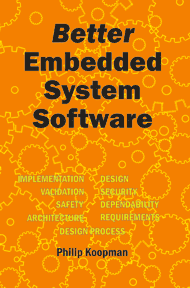 |
|
Better Embedded System Software
Philip Koopman, 2010, 397 pages, ISBN-13: 978-0-9844490-0-2
This book distills the experience of more than 90 design reviews on real
embedded system products into a set of bite-size lessons learned in the areas
of software development process, requirements, architecture, design,
implementation, verification & validation, and critical system properties.
Each chapter describes an area that tends to be a problem in embedded system
design, symptoms that tend to indicate you need to make changes, the risks of
not fixing problems in this area, and concrete ways to make your embedded
system software better. Each chapter is relatively self-sufficient, permitting
developers with a busy schedule to cherry-pick the best ideas to make their
systems better right away.
This book is about the bigger picture on embedded software design and how to
get it right in an industry setting.
There is also an accompanying
blog.
You can also get this from
Amazon
if you prefer, but usually the price is higher than with the author discount.
|
|
Computer Architecture and Embedded Systems:
These books generally assume you have some knowledge of digital hardware
design and want to start with how "bare metal" programming is done.
So they start with a CPU and its assembly language, and work up from there.
Books of this type often are associated with classical "Intro to
Microprocessors" courses in undergraduate computer engineering programs.
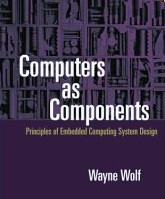  |
|
Computers
as Components: principles of embedded computing system design
Wayne Wolf, 2001, 662 pages
This book was written by one of the leading academics in the field of embedded
systems, at Princeton University. It comes from the point of computer hardware
design (intended audience: undergraduate computer engineering students), and so
starts with CPUs and assembly language. It moves on to cover the main points in
CPU accelerators, software design, operating systems, networks, and system
design techniques. This is one of the more thorough embedded systems books and
one of the few that is a comprehensive text. The first portion of the book has
solid coverage on microcontroller operation and usage. The back half of the
book gradually turns into a survey of advanced topics at a higher level.
Examples are for the relatively high-end ARM and SHARC processors, in both
assembly language and C. But the book is not overly dependent on the specifics
of examples and could be used fairly easily with other processors as well.
Probably this is the best current big-CPU text in this category. |
|
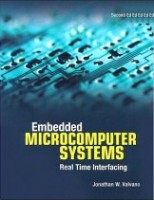  |
|
Embedded
Microcomputer Systems: real time interfacing
Jonathan Valvano, 2006, 840 pages
This is a text for a relatively traditional microcontrollers course by a
professor at UT Austin. It seems mostly intended for third- and fourth-year
undergraduate students. It has very extensive coverage of assembly language,
interfacing, interrupts, timing, I/O and the like. The emphasis is on
understanding all the gory details as a way to see how things really work,
although some readers find the approach concentrates too much on details and
not enough on the big picture. The book uses extensive examples from the
Motorola 6811 and 6812 family of 8- and 16-bit processors (more recently known
as Freescale processors, such as the MC68HC12) and probably would only be
useful in conjunction with that family of processors programmed in assembly
language or C.
Probably this is the best current small-CPU text in this category. |
|
C/C++ Programming and Embedded Systems:
These books assume you know some C or C++ programming, but don't know a lot
about the underlying hardware. If you have done desktop programming and want to
learn embedded systems these are a reasonable starting point. Often this is
where computer scientists start.
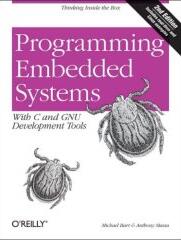  |
|
Programming
Embedded Systems: With C and GNU Development Tools, 2nd Edition
Michael Barr, 2006, 301 pages.
Michael Barr was editor of Embedded Systems Programming magazine for many
years, and certainly knows how to write well. This book is a gentle
introduction to the world of embedded computing (and system programming) that
lies beyond ordinary desktop programming. It really more about how system
programming works (operating systems, memory management, tool chains) than it
is about embedded hardware. It is more about having common ideas, tricks, and
techniques than comprehensive coverage -- so you'll want to move on to another
book after you digest this one. But, it is well written and is justifiably
popular as a first introduction. The book is in general independent of which
CPU you are using, although with GNU tools I'd expect the second edition
emphasizes 32-bit processors. Examples are in the C programming language.
This is a good place to start if you want to transition from desktop to
embedded C programming.
(This review is based on the first edition; the second edition includes GNU
development tools) |
|
Real Time and Embedded Systems:
These books emphasize the operating system and real time scheduling aspects
of embedded system design. Some of them put equal emphasis on software
development practices.
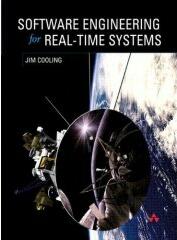 
|
|
Software
Engineering for Real-Time Systems
Jim Cooling, 2002, 787 pages
This thick book covers the real time programming aspects of embedded systems,
with particular emphasis on software design techniques within the context of
using a real time operating system (RTOS). This is a nice book for developers
who are going to spend most of their time writing code for a fairly complex,
"big" embedded system, especially in the aerospace and defense
domains. There is a heavy emphasis on concepts and diagrams. There is almost no
emphasis on writing actual code (which can be a good thing, since good design
and architecture skills are much more important than mere ability to write
code). Because there isn't really any coding, the book is processor and
language independent. There are no homework questions and no problem
assignments, so it is not a ready-made textbook, but it looks reasonable for
use as a text if accompanied by instructor-created assignments. |
|
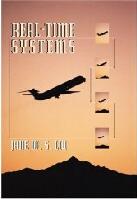  |
|
Real-Time
Systems
Jane Liu, 2000, 610 pages
This book is about mechanisms and theory underlying real time operating
systems, such as scheduling theory, resource management, and access control.
It's a solid textbook for a fourth-year undergraduate or Master-level college
student. The book is largely language and processor independent, since it is
about math and theory more than actually writing code. If you want to learn
real time theory, this is a good starting point. |
|
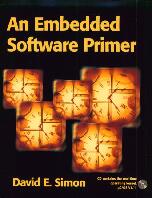  |
|
An
Embedded Software Primer
David Simon, 1999, 448 pages
This book provides an introduction to hardware, and discusses software
development. But the heart of the book is embedded software in the context of
real time operating systems, including interrupts, multitasking approaches, and
real time operating system services. It uses the uCOS-II RTOS, but is
processor-independent due to the use of the "C!!" programming
language ("!!" comment is used to describe hardware-dependent actions
in English text). It's popular based on the accessibility of both its writing
and the included software tools that will run on a PC. |
|
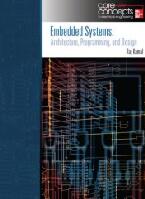  |
|
Embedded
Systems: Architecture, Programming, and Design
Raj Kamal, 2006, 672 pages
This text by an Indian professor covers aspects of creating software for
embedded systems built on top of a real time operating system (RTOS). The main
concentration areas of the book are software design, device drivers, and using
RTOS services. Examples are in C and C++ and there are some brief problem
sections. |
|
Hardware/Software Codesign:
Some high-end embedded systems involve creating both customized hardware and
software to run on that hardware. These books look at embedded systems from the
point of view of customized hardware (often in the form of a "system on
chip") or FPGAs as augmentation to a standard processor.
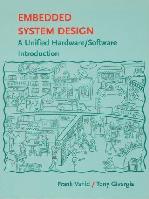  |
|
Embedded
System Design: a unified hardware/software introduction
Frank Vahid, Tony Givargis, 2001, 352 pages.
The authors of this book developed it as an introduction to embedded systems
text at UC Irvine and UC Riverside. It does a high-level overview of embedded
systems, with an emphasis on building such systems out of a combination of a
standard microcontroller and an FPGA for accelerating key computational
functions. This book is a good starting point for someone who wants to progress
to semi-custom chip design as a next step. The book is processor-independent.
There is some example C code but that language is not essential to
understanding the book. |
|
Lots of Example Code:
These books emphasizing providing a substantial amount of working code,
usually for a specific processor. In general these books are best for two
purposes, although some are broader than this: (1) a source of code as a
starting point for a project; and (2) examples of code to study to see how
others do things.
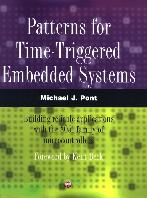  |
|
Patterns
for Time-Triggered Embedded Systems
Michael Pont, 2001, 1024 pages.
The author of this book is at the University of Leicester, in the UK. The
emphasis is on using C code in two ways. First, a very extensive set of
chapters explains how to interface with an impressive array of I/O devices (the
most complete such list I can recall seeing). The second emphasis is on how to
build a time-triggered architecture, which is a generalization of cyclic
executives that has some significant advantages for embedded control systems.
The examples are for an 8051, and the portions of the code that deal with
setting up control registers and so on are specific to that architecture.
However, the discussions of how I/O devices work and the general code flow are
still useful for understanding other processors.
This is probably the "full of code" book I like the most. |
|
Safety and Critical Systems:
These books emphasizing creating embedded systems that are safe, dependable,
or otherwise have higher integrity than ordinary "desktop-quality"
software.
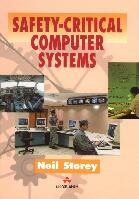  |
|
Safety-Critical
Computer Systems
Neil Storey, 1996, 453 pages.
Although it has been a while since it was written, I consider this the most
practical and useful textbook on safety critical computer systems. It covers
all the aspects of safety-critical design, based mostly on hardware approaches.
While software is certainly discussed, it is not so easy to apply these
techniques to software in practice -- but that situation hasn't changed all
that much in the decade since the book was written. It is independent of
programming language and processor. The biggest gap is that IEC 61508 happened
after this book was written, so it isn't discussed.
If you want to learn about how to deal with safety in an embedded system
context, this is the best book to start with. |
|
Other Books:
These books don't really aim to teach embedded systems, but can be useful
supplemental and reference materials.
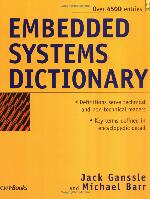  |
|
Embedded
Systems Dictionary
Jack Ganssle & Michael Barr, 2003, 291 pages
This book is an extended glossary of over 4500 terms relevant embedded systems.
Coverage includes hardware, software, controls, real time systems, and program
management. If you aren't sure where the holes in your knowledge are, you can
learn a lot just by browsing through to see what concepts you've been missing.
The authors have both been writing (and editing) for years, so readability is
excellent. |
|
Sponsored Advertisement:











